Chem. Eng. J.|Constructing MXene@CoS₂/NC hollow heterostructures and optimizing Co-S bonds to improve the conversion reaction kinetics of anode materials for sodium-ion batteries
QQ Academic Group: 1092348845
Detailed
North Konami can provide MXene (can be customized)
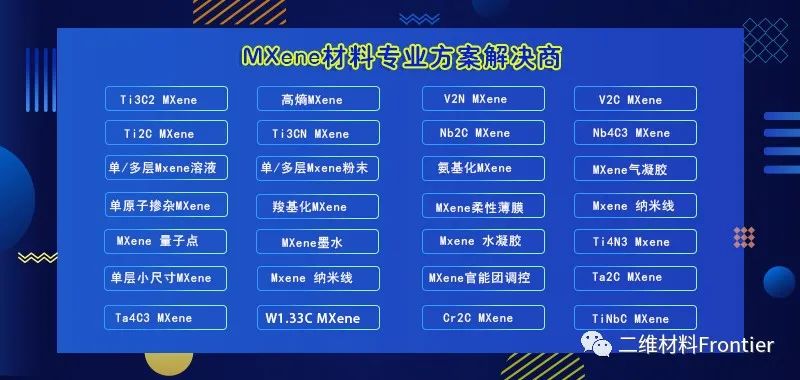
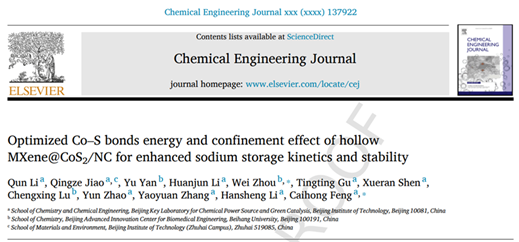
Research abstract
As a potential anode material for Na-ion batteries, cobalt disulfide (CoS2) possesses better electrical conductivity than most transition metal sulfides and has a theoretical capacity as high as 827 mAh/g. However, it still suffers from the bottleneck of sluggish sodium storage kinetics and volume expansion. Considering the conversion reaction mechanism of CoS2, accelerating the reversible conversion from CoS2 to Na2S can improve the specific capacity, rate capability, and long-term cycling stability of CoS2. Optimizing the Co-S bond energy can accelerate the reversible transformation of CoS2. By introducing additional substrates or specific heterointerfaces, the construction of heterostructures is a feasible way to optimize the Co-S bond energy.
In addition, the use of substrates or the construction of hollow structures can alleviate the volume expansion of metal sulfides during charge and discharge. It is well known that thin-layer two-dimensional (2D) transition metal carbonitrides (MXenes) have attracted increasing attention in the field of energy storage and conversion due to their high metallic conductivity, surface hydrophilicity, and good mechanical stability. The well-designed and assembled 3D hollow structures based on MXene nanosheets can provide an ideal host structure to avoid the repacking of 2D nanosheets, increase the contact interface between electrodes and electrolytes, and alleviate the volume change through the internal hollow structure. Considering the abundant functional groups (-OH, -OOH, -F, etc.) on the surface of Ti3C2Tx MXene, the interaction between Co(II) and Ti3C2Tx MXene can reduce the Co-S bond energy in metal sulfides. Based on the above considerations, we used polymethyl methacrylate spheres (PMMA) as templates to assemble Ti3C2Tx MXene nanosheets to form MXene hollow spheres to anchor CoS2 nanoparticles. Besides the interface between CoS2 and MXene, the interface between CoS2 and MOF-derived nitrogen-doped carbon (NC) is also beneficial to reduce the Co-S bond energy and improve the conversion reaction kinetics.
Introduction
Recently, Associate Professor Feng Caihong from Beijing Institute of Technology and Professor Zhou Wei from Beihang University used hydrogen bonding to self-assemble MXene nanosheets on the surface of PMMA spheres. Co2+ ions are anchored on the surface of PMMA@MXene spheres through electrostatic adsorption with oxygen-containing functional groups on the surface of MXene, and these functional groups can further act as nucleation sites and in situ grow ZIF-67 polyhedra on the MXene surface to form PMMA@MXene @ZIF-67. Finally, through the carbonization and vulcanization process, the PMMA template is removed and the composition transformation is achieved, resulting in hollow MXene@CoS2/NC. MXene@CoS2/NC exhibits excellent sodium-ion storage properties, including a high reversible capacity of 620 mAh g-1 at a current density of 0.2 A g-1, and excellent cycling stability (capacity remains at 355 after 5000 cycles). mAh g-1). Corresponding electrochemical tests demonstrate the fast Na+ ion diffusion rate of MXene@CoS2/NC. XPS and XANES characterization revealed that the introduced MXene and pyrrolic N could weaken the Co-S bond of CoS2, which favored the conversion reaction between CoS2 and Na2S, thereby improving the sodium ion storage kinetics. DFT calculations also demonstrate that the introduction of MXene can enhance the conductivity of the electrode material through fast interfacial electron transfer. In addition, MXene hollow spheres and MOF-derived NCs provide a host structure for CoS2, which can increase the contact between electrolyte and active material and buffer the volume expansion of CoS2.
The result was published online in the top international journal Chemical Engineering Journal with the title: Optimized Co-S bonds energy and confinement effect of hollow MXene@CoS2/NC for enhanced sodium storage kinetics and stability.
Dr. Qun Li from Beijing Institute of Technology is the first author of this article.
Graphical guide
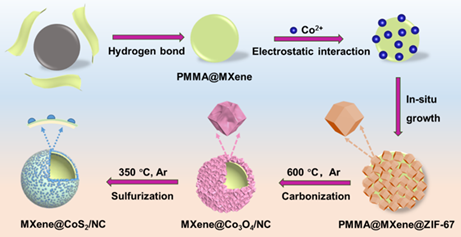
Figure 1. Schematic diagram of the preparation process of MXene@CoS2/NC composites.
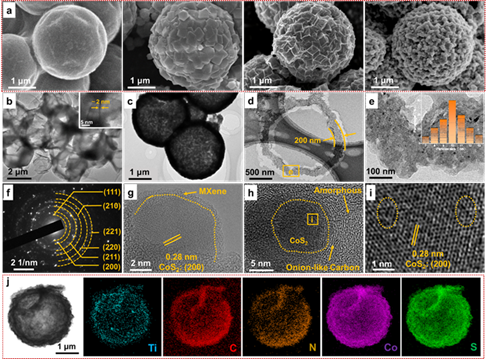
Figure 2. (a) From left to right, the SEM images of PMMA@MXene, PMMA@MXene@ZIF-67, MXene@Co3O4/NC and MXene@CoS2/NC. (b) TEM image of the MXene hollow sphere, with the inset magnified section showing its thickness. (c-e) TEM and cross-sectional TEM images of MXene@CoS2/NC, (e) inset is the size distribution of CoS2 nanoparticles, (f) SAED image of MXene@CoS2/NC, (g-i) MXene@CoS2/NC HRTEM image, (j) STEM image and corresponding element distribution map of MXene@CoS2/NC.
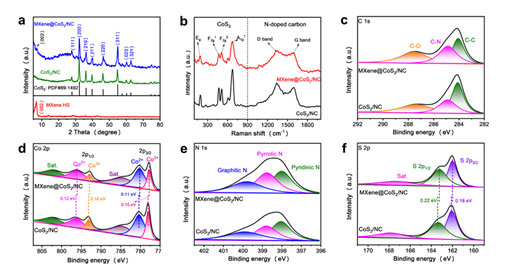
Figure 3. (a) XRD patterns of MXene@CoS2/NC, CoS2/NC and MXene. (b) Raman spectra of CoS2/NC and MXene@CoS2/NC. (c–f) XPS fine spectra of C 1s, Co 2p, N 1s and S 2p in MXene@CoS2/NC and CoS2/NC.
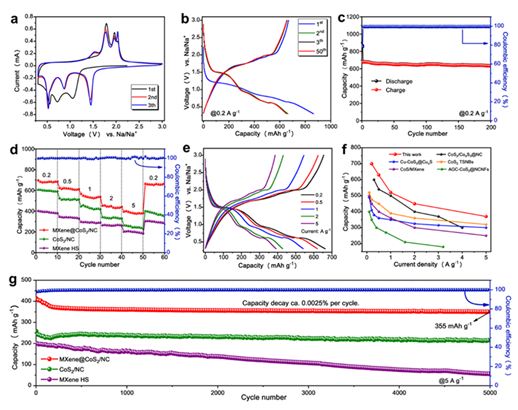
Figure 4. Electrochemical performance testing. (a) CV curves of MXene@CoS2/NC. (b) The charge-discharge curves of the first three and 50th cycles of MXene@CoS2/NC. (c) Cycling performance of MXene@CoS2/NC at 0.2 A g-1. (d) Rate performance of MXene@CoS2/NC, CoS2/NC and MXene at different current densities. (e) The charge-discharge curves of MXene@CoS2/NC at different current densities. (f) Rate performance comparison of MXene@CoS2/NC with other cobalt sulfide-based anode materials. (g) Long-term cycling stability of MXene@CoS2/NC, CoS2/NC and MXene.
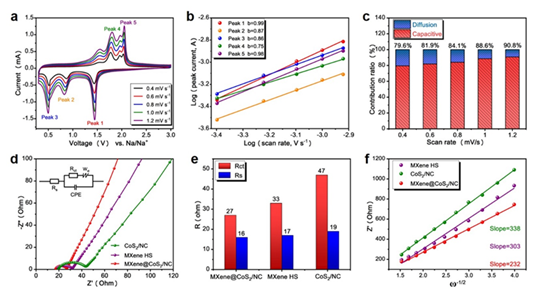
Figure 5. (a) CV curves of MXene@CoS2/NC at different scan rates. (b) log(i)-log(v) plot of different peaks. (c) Capacitance contribution at different scan rates. (d) Nyquist plots of MXene@CoS2/NC, CoS2/NC and MXene electrodes, the insets are the corresponding equivalent circuits. (e) Histograms of Rs and Rct values for MXene@CoS2/NC, CoS2/NC and MXene electrodes. (f) The relationship between Z and ω-1/2 in the low frequency region of MXene@CoS2/NC, CoS2/NC and MXene electrodes.
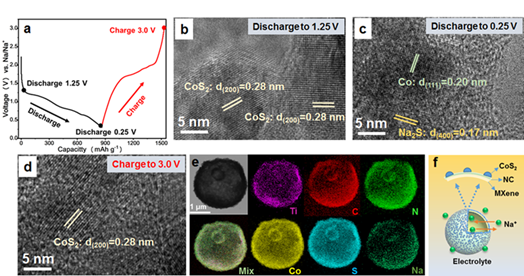
Figure 6. EMI shielding mechanism analysis. (a) The charge-discharge curves of MXene@CoS2/NC in the first cycle. (b)-(d) Ex-situ HRTEM images of MXene@CoS2/NC at different charge-discharge stages: (b) discharged to 1.25 V, (c) discharged to 0.25 V and (d) charged to 3.0 V. (e) TEM image and elemental distribution map of MXene@CoS2/NC after discharge to 0.25 V. (f) Schematic illustration of the structural advantages of MXene@CoS2/NC electrodes.
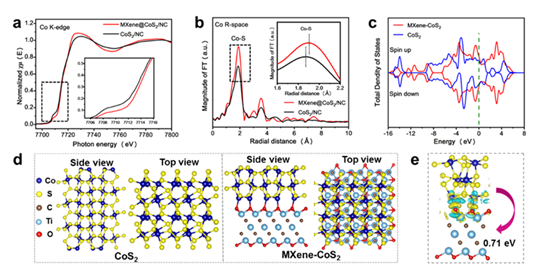
Figure 7. (a) Normalized Co K-edge XANES spectra of MXene@CoS2/NC and CoS2/NC, the inset shows the magnified pre-edge peak region; (b) Co K-edge of MXene@CoS2/NC and CoS2/NC FT-EXAFS spectra of , the inset is the enlarged Co-S region; (c) DOS maps of MXene/CoS2 and CoS2; (d) constructed CoS2 and MXene/CoS2 models; (e) differential charge on the MXene/CoS2 interface Density distribution, blue and yellow regions represent the accumulation and depletion of charge density, respectively.
Summarize
In this work, MXene@CoS2/NC hollow spheres with optimized heterointerface Co-S bond energy were prepared by carbonization and vulcanization of PMMA@MXene@ZIF-67. When MXene@CoS2/NC hollow spheres are used as anode materials for SIBs, they exhibit excellent electrochemical performance, including a high reversible specific capacity of 620 mAh g-1 at 0.2 A g-1 and long-cycle stability of 5000 cycles and excellent rate performance. The improved kinetics and electrochemical stability can be attributed to the synergistic effect of MXene and in situ grown MOF-derived CoS2/NC, which optimizes Co-S by tuning the electron cloud density around Co through the Co-O chemical bond at the heterointerface. key key. Furthermore, DFT calculations show that MXenes can enhance the conductivity of electrode materials through fast interfacial electron transfer. Meanwhile, the hollow structure of MXene@CoS2/NC can not only increase the contact area between the electrode and the electrolyte, but also relieve the volume expansion of the electrode material to maintain the stability of the structure. This work provides a new strategy for designing and fabricating MXene@CoS2/NC hollow sphere structures.
Literature link
https://doi.org/10.1016/j.cej.2022.137922
- Previous: CSR review: 2D MXenes
- Next: MXene breakthrough: Na


 mxene academic
mxene academic